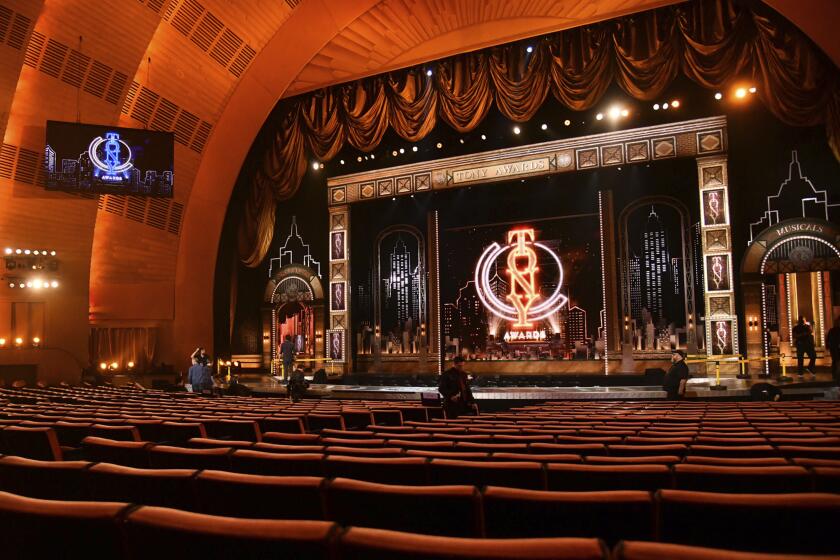MODERN ART SETTLES INTO DOMESTICITY
- Share via
By most standards the qualities of cultivation, refinement and cosmopolitanism are virtues. Modern art, however, made its reputation as a bracingly abrasive poetic irritant out to upset comfortable preconceptions and so it is a matter of some sadness to watch it slowly settle into well-mannered domesticity.
This house-breaking of the modernist tradition is so widespread as to almost escape notice, like a mildly smoggy day you barely register because of the uniformity of the atmosphere. It is so pervasive that it seems to represent a historical tide that will go forward whether resisted or accepted.
Four exhibitions current at the Municipal Art Gallery to April 7 are all affected by the slick and courtly reigning Zeitgeist . Everybody is cosmopolitan and most everybody evidences symptoms of the Occidental notion of the ne plus ultra of refinement, Oriental refinement.
Kazuo Kadonaga is a Japanese sculptor who mixes traditional Oriental philosophy with forms of modernist process art. He makes art out of bamboo or tree trunks that appear at a glance to be left in fairly natural shape considering they have been cut down. Kadonaga’s trademark work is a barkless cedar or cypress trunk cut with the grain into hundreds of wafer-thin layers. Glued back together the layers then begin a natural process of peeling and curling. In other works Kadonaga saws or splits checkerboard, zigzag or other patterns into of logs which then split along their own rings. Bamboo is splintered into broom-like textures or heated to alter its color.
All of this can be convincingly interpreted as an updating of a Zen aesthetic where the artist interacts with nature to coax its essence to the surface as is done in ink painting and sand gardens. It also reads as an exercise in pointless ingenuity like a catered turkey that has been deboned and put back together.
Twenty years ago it was possible to set off powerful aesthetic waves by just bringing a giant redwood log into an art gallery as an artist did at the old Pasadena Museum of Modern Art. Today a whole gallery full of lovely lumber stirs only the most delicate aesthetic breezes, admiration for craftsmanship and polite dismay at dogged methodology straining for invention.
Much the same profile fits two smaller exhibitions. Japanese-American Akemi Uchiyama makes exquisitely crafted wall-to-floor wooden box constructions that employ bamboo, rice paper, sand, rocks and rope. There are hints of wit in several examples and a whiff of social satire in the architectural “Respected Privacy” that doesn’t do anything of the sort. Generally, however, the expressive frisson is so attenuated that work is almost pure object d’art.
Chinese-American Betty Tsu Fong presents a walk-in installation that is said to, “allude to a woman raised in Chinese Confucian culture making the transition to contemporary life in America.” It consists of pop-up Toaist ritual path with way stations of enlightenment that finally leads to a sterile silver monolithic niche. The literal symbolism may fulfill the literary theme but it is so artistically jarring the work falls apart.
L.A. artist Jud Fine shares the main stage with Kadonaga and counters his big logs with an uncharacteristically large process work called “Drop.” This consists of a chunky metal pipe 60 feet long that rests at the bottom of a large elliptical rip in an interior display wall. Clearly intended as a dramatic evocation of kinetic force, it reads simply as a cosmetic sight gag like those Best & Co. buildings made to look like they are falling down or splitting in the middle.
“Drop” fails to work partly because it is not visually logical or convincing but mostly because its premise has long since been tamed and annexed to the ordinary vernacular of commercial architecture.
One of Fines greatest--and diceyest--qualities has been his attempt to associate art with other important disciplines such as philosophy or anthropology. He is up to that again here in paintings that include maps, writing and diagrammatic drawings. They refer directly to navigation and allude, as his work usually does, to primitive cultures. He conjures up a whole range of ecological questions but his patterning has gotten so pretty that cosmic issues take on the tone of cosmetic small talk.
The Barnsdall Park exhibition is not a poor or wrong-headed show and the fine catalogue is especially nice. It just happens to be picking in a greenhouse rapidly turning into a hothouse for evermore exotic, rarefied and fragile orchids.
More to Read
The biggest entertainment stories
Get our big stories about Hollywood, film, television, music, arts, culture and more right in your inbox as soon as they publish.
You may occasionally receive promotional content from the Los Angeles Times.










